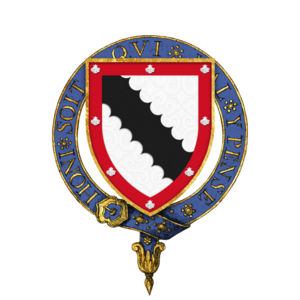Richard Ratcliffe facts for kids
Sir Richard Ratcliffe (died August 22, 1485) was a very trusted friend and advisor to Richard III of England. He was an important knight during the time of the Wars of the Roses in England.
Contents
Sir Richard Ratcliffe's Story
Richard Ratcliffe came from a family of gentry (people who owned land but were not nobles) in the beautiful Lake District area of England. He became a close companion of Richard when Richard was still the Duke of Gloucester. This was before Richard became king.
As a trusted friend, Ratcliffe was given important jobs. He helped manage some of Richard's lands and was put in charge of Barnard Castle. Richard, while still a Duke, made Ratcliffe a knight during battles in Scotland. This was a special honor called a knight banneret.
Helping Richard Become King
When Richard was trying to become king, Ratcliffe was chosen for a very important task. He went back to the north of England to gather an army. This army was meant to help Richard, who was then called the "Protector" of England. Some historical writings say that Ratcliffe was the one who ordered the execution of Anthony Woodville, 2nd Earl Rivers.
Rewards and Riches
After Richard became King Richard III, he gave Ratcliffe many important positions. These included being the High Sheriff of Westmorland, a top law enforcement role. He also made Ratcliffe a Knight of the Garter, which is a very high honor in England.
Ratcliffe also received a lot of land from the king. Much of this land had belonged to the Courtenay Earls of Devon. After a rebellion in 1483, Ratcliffe was given even more land that had been taken from people who rebelled. Because of all this land, he became very wealthy, even richer than most barons (a type of noble).
A Famous Poem
In July 1484, a man named William Collingbourne wrote a funny, but critical, poem. He nailed it to Old St Paul's Cathedral in London. The poem talked about three of King Richard's main helpers, including Ratcliffe:
The Catte, the Ratte and Lovell our dogge rulyth all Englande under a hogge.
This poem used nicknames:
- "The Catte" was William Catesby.
- "The Ratte" was Sir Richard Ratcliffe.
- "Lovell our dogge" was Francis Lovell, 1st Viscount Lovell. His family symbol was a white wolf, which looked like a dog.
- "A hogge" was King Richard III himself. His special symbol was a white boar, which is a type of wild pig.
This poem was even used in the famous movie Richard III, which was based on Shakespeare's play.
Family Life
Sir Richard Ratcliffe married Agnes Scrope. Her father, Henry Scrope, 4th Baron Scrope of Bolton, was one of the most powerful nobles in the north of England.
Ratcliffe was one of two close advisors (the other was William Catesby) who reportedly told King Richard that marrying Elizabeth of York would cause problems and rebellions in the north of England.
His Final Battle
Sir Richard Ratcliffe was killed in a major battle called the Battle of Bosworth Field. This battle took place on August 22, 1485. It was a very important battle that ended the Wars of the Roses and brought a new king to the throne.
Sir Richard in Plays and Movies
Sir Richard Ratcliffe appears as a small character in William Shakespeare's famous play Richard III. In the play, he is shown carrying out the executions of Rivers, Grey, and Vaughn.
In the 1995 movie version of Richard III, which starred Ian McKellen, Ratcliffe is played by Bill Paterson. In this movie, Ratcliffe acts as King Richard's personal assistant or "batman."


